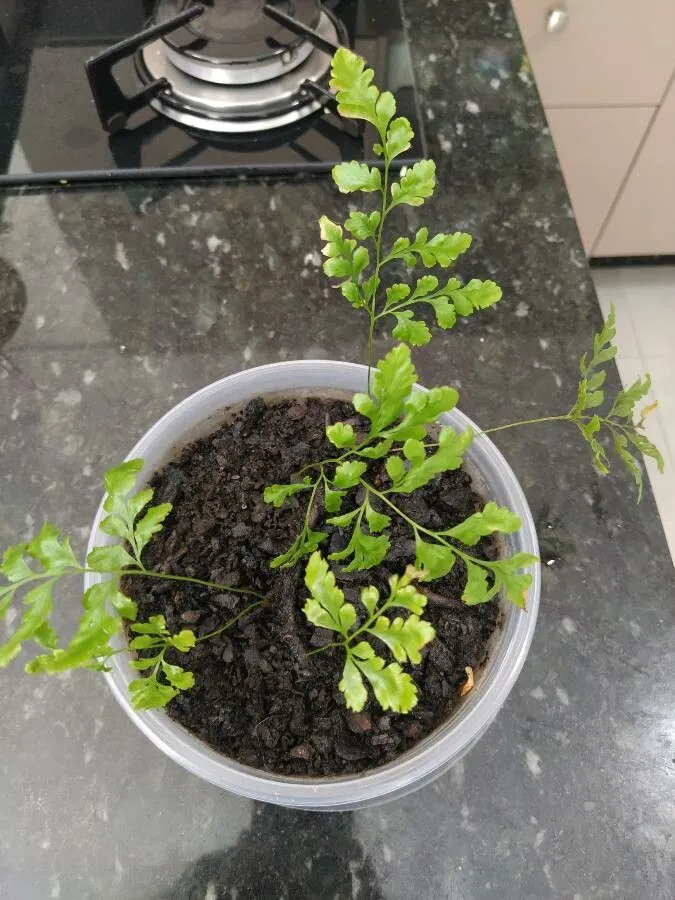
Author: (G.Forst.) Ching
Bibliography: Sinensia 5: 70 (1934)
Year: 1934
Status: accepted
Rank: species
Genus: Rumohra
Vegetable: False
Observations: Trop. & Subtrop. America, Subantarctic Is., Zimbabwe to S. Africa, W. Indian Ocean, New Guinea, E. & SE. Australia, New Zealand
Leather fern, scientifically known as Rumohra adiantiformis, is a versatile and widespread species belonging to the Polypodiaceae family. Described by (G.Forst.) Ching in a detailed study documented in Sinensia 5: 70 (1934), this plant is appreciated for its hardy nature and distinct appearance.
Rumohra adiantiformis thrives in a variety of climates and geographical regions, underscoring its remarkable adaptability. Its natural habitat extends across tropical and subtropical regions of the Americas, with a notable presence in Subantarctic islands. The fern also spans across the African continent from Zimbabwe to South Africa, and is found in the western Indian Ocean regions. Moreover, it graces the rich flora of New Guinea, eastern and southeastern Australia, and New Zealand.
This fern features leathery, lustrous fronds which contribute to its common nomenclature. The resilient texture of the fronds makes it an ideal choice for use in floral arrangements, as the leaves can withstand substantial handling and long-term display without wilting. Its robust nature has made it a popular choice among florists and gardeners alike.
Leather fern’s ecological range encompasses diverse environments, from moist forests to mountainous regions, demonstrating a high tolerance to varying soil and climatic conditions. Its widespread nature and resilience make it a fascinating subject of study for botanists and plant enthusiasts who are keen on understanding plant adaptability and distribution patterns.
In summary, Rumohra adiantiformis, or leather fern, is a striking and adaptable fern with a broad geographical range. Its leathery fronds are both aesthetically pleasing and durable, making it a preferred species in both natural and cultivated settings. The study and appreciation of this fascinating plant continue to contribute significantly to our understanding of botanical diversity and plant resilience.
Eng: iron fern, leather fern, leatherleaf fern, ten-day fern
Deu: lederfarn
Spa: calaguala
Swe: läderbräken
Por: samambaia-preta
En: Leather fern, Leatherleaf fern, Iron fern, Ten-day fern
De: Lederfarn
Pt: Samambaia-preta
Es: Helecho cuero, Calaguala
Sv: Läderbräken
Taken May 12, 2021 by Daan Wessels (cc-by-sa)
Taken Jan 2, 2021 by david johnson (cc-by-sa)
Taken Feb 9, 2021 by sg Seah (cc-by-sa)
Taken Oct 1, 2021 by Trap Hers (cc-by-sa)
Taken Dec 25, 2021 by maurity rafaela (cc-by-sa)
Taken Apr 23, 2014 by EOL − Leon Perrie (cc-by-nc-sa)
Taken May 31, 2021 by Arnaud (cc-by-sa)
Taken Feb 28, 2022 by Trap Hers (cc-by-sa)
Taken Apr 3, 2016 by EOL − David Hutchinson (cc-by-nc)
Taken Nov 22, 2015 by EOL − David Hutchinson (cc-by-nc)
Taken Nov 23, 2014 by EOL − Mike Lusk (cc-by-nc)
Taken Apr 23, 2014 by EOL − Leon Perrie (cc-by-nc-sa)
Taken Nov 2, 2015 by EOL − David Hutchinson (cc-by-nc)
Taken Feb 25, 2022 by D.Lima Yas (cc-by-sa)
© copyright of the Board of Trustees of the Royal Botanic Gardens, Kew.
© copyright of the Board of Trustees of the Royal Botanic Gardens, Kew.
© copyright of the Board of Trustees of the Royal Botanic Gardens, Kew.
Taken Oct 1, 2021 by Trap Hers (cc-by-sa)
Taken Oct 4, 2020 by Böthig Silvia (cc-by-sa)
Taken Oct 4, 2020 by Böthig Silvia (cc-by-sa)
Taken Oct 1, 2021 by Trap Hers (cc-by-sa)
Taken Dec 21, 2015 by EOL − Tim Park (cc-by-nc)
Taken Dec 21, 2015 by EOL − Tim Park (cc-by-nc)
Taken Nov 2, 2015 by EOL − David Hutchinson (cc-by-nc)
Taken Mar 18, 2016 by EOL − David Hutchinson (cc-by-nc)
Taken Feb 25, 2022 by D.Lima Yas (cc-by-sa)
Growth habit: Forb/herb
Family: Myrtaceae Author: (F.Muell.) K.D.Hill & L.A.S.Johnson Bibliography: Telopea 6: 402 (1995) Year: 1995 Status:…
Family: Rubiaceae Author: Pierre ex A.Froehner Bibliography: Notizbl. Bot. Gart. Berlin-Dahlem 1: 237 (1897) Year:…
Family: Sapindaceae Author: Koidz. Bibliography: J. Coll. Sci. Imp. Univ. Tokyo 32(1): 38 (1911) Year:…
Family: Asteraceae Author: A.Gray Bibliography: Pacif. Railr. Rep.: 107 (1857) Year: 1857 Status: accepted Rank:…
Family: Fabaceae Author: Medik. Bibliography: Vorles. Churpfälz. Phys.-Ökon. Ges. 2: 398 (1787) Year: 1787 Status:…
Family: Aspleniaceae Author: (Cav.) Alston Bibliography: Bull. Misc. Inform. Kew 1932: 309 (1932) Year: 1932…